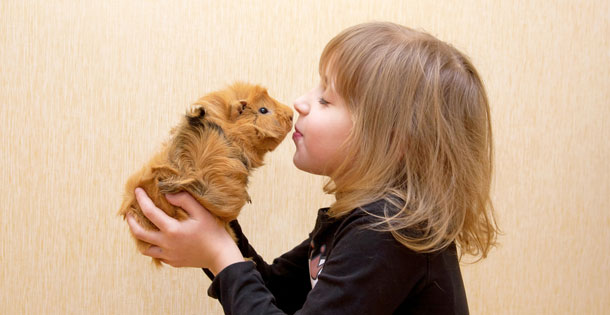Five years ago, we found Gregory, a russet-toned guinea pig with unusually large eyes, at one of those “big box” pet stores that seem to be everywhere, high-ceilinged, cavernous emporiums with aisle after aisle of merchandise. He was furtively rooting in the bedding at the bottom of a tall, rectangular cage that seemed intended for birds, rather than ground-dwelling rodents. When I knelt for a closer look he backed into a purple plastic igloo and bugged his eyes at me. One of his ears hung limp. It was notched down the center as though it had been split and then healed. He had scratch marks on his muzzle, hatches of white skin showing through the brown fur. I stood and backed away from the cage.
I caught my husband Bob’s eye and frowned. He grimaced back in unspoken agreement. We did not intend to bring this battle-scarred guinea pig home with us.
“How about some lunch?” I said, with forced cheeriness.
“Yeah, yeah,” he said. “I could eat. Burrito World?”
We both looked to Rachel, our daughter, 11 at the time. Burrito World was her favorite. But she didn’t seem to have heard. She’d slumped to the linoleum, feet splayed out beside her, fingers laced through the cage’s metal bars.
“Can I hold him?” she said.
“Really?” I said. “Maybe they have others.”
“Mom.”
“What?”
“He can’t help it,” she said. “It’s not his fault if he got in a fight.”
There was a hitch in her voice, and her eyes were bright with hope.
The clerk, a gangly young man with a weak chin, claimed not to know much about the brown guinea pig’s personal history.
“I’m thinking he was sent over from another store,” he said, which sounded vaguely ominous.
“What if he’s a biter?” I said.
“Mom.”
“I can’t return your money,” the clerk said. “But we’ll take him off your hands. Just bring him back if you don’t want him. No problem.”
Rachel sat in the backseat on the way home, a cardboard box with a handle and two rows of air holes on her lap.
“What’s your name, little one?” she said, peering in at her new pet.
We both glanced at our youngest child in the rearview mirror. She was the last of five, the only one still at home and our one child together.
**
Cavies, the more proper name for guinea pigs, belong to the genus Cavia. They are naturally social creatures. Which was why we were in search of another. Harold, our daughter’s other cavy, had recently lost his two cage mates, first Jelly Bean and then Skittles, with little warning, at least none that we’d noticed. Harold, the lone survivor, had impractical long, curly hair. No bigger than a packet of tissues when we got him, he was a birthday gift from my mother a year prior.
On a spring Saturday, not long after we brought Gregory home from the pet store, Rachel was in the family room, setting up an obstacle course for the pigs’ daily exercise regimen on the area rug that ran the length of the couch. She lifted segments of plastic pipe from their habitat and placed them in a zigzagged pattern from one end of the rug to the other. Gregory and Harold chattered and squeaked when she removed their plastic igloos to place at either end of the course. Gregory’s squeak was a high-pitched blast that sent Harold racing around his half of the cage, searching for cover. He shoved his nose beneath a rumpled towel and wriggled under until he was a lump of pink terry cloth.
A quarter of the family room, cordoned off with a low wire fence, was given up to the pig habitat. We’d lined the floor with plastic sheeting and towels, and liberally sprinkled the area with fresh hay. The room smelled like a barn. Rachel’s three cavies used to roam the structure freely, but since Gregory, the cage had been split down the middle. He hadn’t hurt Harold, but the clucking and teeth chattering and the way he sidled around the smaller pig, nipping and flicking his nose in the air, were worrisome.
Rachel snapped carrots into chunks and set them between the segments of pipe to lure the pigs from one end of the course to the other. She retrieved a spiral notebook from the hearth and turned to a fresh page, smoothed it with her hand, then drew two grids, one for Harold and one for Gregory.
“Your turn first,” she said, lifting Harold from his side of the cage. He inched his nose forward and stretched out to full length before venturing into the first segment of black pipe and capturing the carrot at the other end.
“Good job,” Rachel said, as he chewed industriously. She placed a check mark in the first box beside Harold’s name, glanced up at the clock over the television and made a note of the time.
SpongeBob yammered in the background as I loaded the dishwasher. Out the kitchen window, Bob stood atop a ladder, trimming the tall bushes that shielded our yard from the neighbor’s. I waved. He grinned and pumped the pruning shears in the air.
“Hey, sweetie,” I said. “It’s a beautiful day. How about you call Susie? You girls could ride bikes to the park or something. I could pack you a picnic.”
She didn’t look up from her notebook.
“Rachel.”
“I’m busy Mom.”
“Susie had you over. It’s our turn.”
“Right.”
I’d had to work late the prior week and asked Susie’s mother if she could keep our daughter after basketball practice. Bob could have picked her up, but it was a chance for the girls to spend more time together. Rachel hadn’t had a good friend, a “real” friend, since fourth grade.
She started Gregory on the course. Harold sniffed the carpet, snuffling up tiny bits of ground carrot that had fallen from his mouth. The two pigs seemed to pay no attention to one another.
“You have to make an effort if you want to make friends,” I said.
Rachel dropped the notebook onto her lap and crossed her arms over her chest.
“Maybe I don’t want to. Not everyone is like you.”
Harold scrabbled across the wood laminate flooring and darted under the couch. Gregory sniffed the air and took off after him, his body an elongated brown streak. Harold screeched and dug frantically at the floor as Gregory cornered him. Rachel flung herself down on her belly and thrust her arm under the couch. With a startled cry she pulled her arm back out and stared at a bloodied fingertip.
I grabbed the broom from the kitchen cupboard and swished it beneath the couch. When Harold darted out, I scooped him up and set him back in the cage. Rachel captured Gregory and held him close, his nose just beneath her chin.
“It’s okay, little one. I know you didn’t mean it.”
She smoothed Gregory’s fur until his frantic chattering became a guttural, trilling sound. When she returned him to the cage Gregory crossed to the fence that separated him from Harold. The two pigs sidled close to one another so that the lengths of their bodies touched through the wire mesh. Harold fluffed out his hair and cooed. Gregory responded with his throaty trill.
“See, they love each other,” she said, more to herself than to me. “Gregory just never learned how.”
I fetched a Band-Aid and some Neosporin from the hall cupboard. Beside her on the couch, I swabbed and wrapped her fingertip tight.
**
The summer before Rachel started high school, she found Harold on his side. His feet formed two Xs on the cage floor, as though he’d been trotting in his sleep. After a burial ceremony in the backyard she retreated to her room and closed the door. When I tiptoed upstairs to let her know dinner was ready, she stirred from a fetal ball to pull the covers up over her head.
Downstairs, Bob and I kept the TV off and listened for her step on the stairs. The big house, which had been filled to capacity with four teenagers and a newborn when we first moved in together, echoed with her absence.
“No more,” I said. “Gregory is the last one. Ever.”
Bob looked up from his magazine and smiled, a meager effort that only reached the corners of his lips.
**
Gregory began to lose weight, seemingly going the way of Skittles, Jelly Bean, and Harold, who’d all reached a point where they lost interest in food. Like the others, we took him to the veterinary clinic near our house.
“Guinea pigs are like cows. They eat continuously,” the vet said. “Once the stomach loses its ‘prime’ there isn’t much you can do. Try to tempt him with his favorite foods.”
A matter-of-fact woman of late middle age, she gave us a concentrated high-nutrition green food. Per her instructions, we mixed the pungent powder with water to form a mash and attempted to feed him with a baby spoon. When that proved fruitless, we experimented with a liquid medicine dropper. Aside from not eating, Gregory was alert and active. I asked the vet if there wasn’t something else that could be done for him. She suggested we find a practice that specialized in “exotics,” a category that encompassed the smaller mammals, birds and lizards.
The Greenbrier Animal Hospital, where we brought Gregory next, boasted several vets with rodent experience. An earnest young vet with thick glasses in black frames palpated Gregory’s skin, stretching it between her fingers, and said he was badly dehydrated.
Gregory was admitted, hooked up to intravenous fluids and fed the concentrated green mash every four hours. The expenses mounted. But we’d determined to do whatever we could for him. Rachel was scheduled to fly to Washington, D.C., for a school trip in a week. If Gregory didn’t turn a corner, she’d be in no shape to go.
After Gregory spent four days in the hospital, the bespectacled vet was cautiously hopeful. Gregory was hydrated, taking the food well, and he’d begun to poop again.
“That’s a good sign,” the vet said, poking at a poop pellet with her fingertip. “The trick is to get the system moving again.” She gave us instructions for maintaining the every four-hour feeding schedule and for monitoring his stool, both for quantity and shape—sickly pig pellets resemble broken chromosomes rather than uniformly shaped lozenges.
Gregory came home from the hospital.
**
We put Rachel on the airplane with promises to nurse Gregory as if our lives depended on it.
The first shift was mine. When the alarm buzzed at 2 a.m. on the night she left, I slipped into my robe and set up the guinea pig feeding station on the couch — six plastic syringes filled with the green super food nestled in a bowl, and several towels. I swaddled Gregory like a baby, only his head sticking out; held him with one hand; and slowly pressed the plunger into a corner of his mouth, allowing him time to gulp and swallow.
Since our first encounter at the pet store, I’d never really trusted Gregory and had rarely held or patted him. I assumed he’d claw and struggle. Yet once I’d mastered the technique, his small body went limp beneath the towel. His tiny hands were still and his big brown eyes never left mine. After I emptied each syringe, I wiped his muzzle clean with a damp washcloth. In the quiet, darkened house, the tick of the clock and the scrape of the syringe on the bowl the only sounds, I willed life into his 20 ounces of ragged skin, bone, and fur.
**
After a few days, Gregory was greedily sucking down his green food but still unable or unwilling to eat on his own. Though we’d vowed no more guinea pigs, Bob and I decided that if having a companion could make the difference, it was worth a try.
We visited the Humane Society that Saturday. We’d called ahead and knew there were three adolescent brothers left from a litter. They were white with varying patterns of orange splotches and pink eyes. A tattooed and pierced volunteer brought them to us in one of the visitation rooms. We sat on the floor, gave the guinea pig brothers their freedom, and observed as they followed one another nose to tail, snuffling tufts of animal hair that swirled in the corners. One of the three broke away from the others to sniff my pant leg. He didn’t skitter back to the pack when I stroked his back.
Over the phone, Rachel approved our choice and named him Marmalade Jam. We brought Marmalade home. Bob set him in the cage. We breathed a sigh of relief when Gregory sidled closer to the fence between them and settled there.
**
When Rachel’s week in D.C. was over, I was to meet her at the Washington airport so that we could travel together to New York City to spend an additional week with her older sister, a last hurrah before high school. Hours before I was to board the airplane, it was clear Gregory was not yet on the mend. He stuck beside Marmalade yet still wasn’t eating on his own. After his middle of the night feeding, I opened my laptop.
I searched websites dedicated to guinea pig care and dug deeper into the causes of loss of appetite in cavies. Numerous possibilities were offered — stress, infection, dietary and environmental changes. None seemed to apply to any of the four guinea pigs we’d watched languish and die. Clicking through more sites and scrolling down, I stumbled on “malocclusion,” a condition where the guinea pig’s teeth, which continue to grow throughout their life, have overgrown to the extent that they trap the tongue and prevent the pig from chewing and swallowing. There were graphic photographs of guinea pig mouths stretched wide, and of the surgical clamps and clippers used to correct the condition.
I swaddled Gregory, held him under the light, delicately inserted a finger into either side of his mouth to part his black lips, and peered inside. His tongue was thick and humped up, trapped by his teeth. Gregory wasn’t lonely, stressed, or anorexic. Eating was a physical impossibility. I wondered if it had been the same for the others. Shaky with anger and frustration at what we’d put him through, hospitalization and days of pointless, hand feeding, I waited for morning to call the “experts” at the Greenbrier Animal Hospital.
With a new diagnosis, Gregory was admitted for surgery.
I left for the airport.
**
In Manhattan’s Bryant Park, Rachel and I staked out a patch of weedy grass for a free outdoor movie, James Dean in Rebel Without a Cause. She held onto our spot while I bought supper. Returning with sandwiches from a street vendor, I’d just caught sight of her when my cell phone rang. It was Bob. Rachel searched my face and though I said nothing and thought I’d kept my expression blank, she knew. Gregory had survived the surgery. He’d seemed to rally and had even nibbled at some lettuce. Yet he died while Bob was at work. Likely the surgery came too late.
We speed walked from the park to our hotel. Rachel led the way. I struggled to keep pace beside her. That night, in a tiny high-rise hotel room, she wept, heaving and hiccupping until she was out of breath. Long past midnight, the TV screen a senseless blur, I worried Rachel would never stop, that she’d reached a point where she couldn’t.
“Please, sweetie,” I said. “Try to sleep. Someone’s going to call security.”
I was surprised no one had.
**
Rachel is now a high school junior. In 18 months she will leave us and go off to college.
One evening, the first week back at school after winter break, Rachel allowed herself a breather between physics homework and a paper about the Manhattan Project. We sat beside one another on the couch watching television. Marmalade was an orange and white lump on her chest.
“Did you hear from Kathy at all during the break?” I said.
Kathy is her current “best” friend, a girl she eats lunch with every day and shares a number of classes but whom she rarely hears from outside of school.
“Whatever,” Rachel said, with a shrug. “We texted at Christmas and New Year’s. I’m over it. She is what she is.”
She ruffled Marmalade’s fur and leaned her head on my shoulder.
“It’s not that I want to be popular or anything,” she said. “I just think it would be nice to have a real friend, someone that wants to talk to me, to be with me, you know, on their own, without me always initiating it. That’s a thing, isn’t it?”
**
We have learned a few things from eight years of guinea pigs.
Rachel is diligent in feeding Marmalade mainly roughage, plenty of hay, to keep his teeth ground down. And should he stop munching, should he excrete a misshapen pellet, we’ll know to look in his tiny mouth for answers.
Marmalade is not so physically commanding as Gregory. He stays where he’s set, stares with pink piggy eyes, munches carrots and hay with stolid determination, and makes endearing noises when he’s petted. Yet even he, a mostly inert ball of fur, has taught us what Rachel knew all along.
What matters most is being there.
Become a Saturday Evening Post member and enjoy unlimited access. Subscribe now




Comments
What a lovely story.
I thought Gregory was going to make it – damn it!
Lovely story. It underscores what many of us know already — a pet is not just a pet.